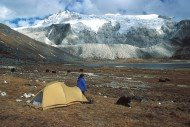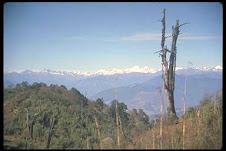Besides the stunning natural scenery, the kingdom of Bhutan offers its visitors the enduring image of architecture. All buildings, whether large monasteries, private houses or even gas stations, must conform to traditional design. The nation is also a bastion of Buddhism, and the teachings of this tradition influence all aspects of life in the kingdom.
Nestling in the lap of the great Himalaya, has for centuries remained aloof from the rest of the world. Since its doors were cautiously opened in 1974, visitors have been mesmerized: the environment is pristine, the scenery and architecture awesome and the people hospitable and charming.
Best Time To come
The ideal time for trekking late-September to late-November when skies are generally clear and the high mountain peaks rise to a vivid blue sky. March-May is recognised as the second-best time to visit Bhutan for touring and trekking. Though there are more clouds and rain, the magnificent wildflowers are in bloom and birdlife is abundant. You're likely to get wet no matter what the season, but avoid the monsoon, June-August, when an average of 0.5m (1.5ft) of rain buckets down in Thimphu and up to 1m (3ft) saturates the eastern hills.
Winter is a good time for touring in western Bhutan, bird watching in the subtropical jungles in the south, and white water rafting. The days are sunny and cool but it's quite cold once the sun sets. From December to February the road from Thimphu to Bumthang and the east may be closed because of snow for several days at a time. It would be best not to plan to visit these regions at this time.
In recent years overcrowding has become an issue during the major tsechus (Buddhist festivals) at Thimphu and Paro, which coincide with the best seasons. You stand a much better chance of getting flights, accommodation and probably a more intimate and rewarding festival experience if you schedule your trip around one of the other cultural events.
Places To See
Bhutan is culturally and geographically divided into three regions, which are further divided into 20 Districts or Dzongkhag (singular and plural):
Central Bhutan — Jakar, the sacred Bumthang Valleys and Jigme Singye Wangchuk National Park
Eastern Bhutan — Mongar and the famous cloth weaving area of Lhuentse
Western Bhutan. — Thimphu, Phuentsholing and the sacred valley of Paro
Trekking: Bhutan is a popular place for trekking, though the walks are generally quite tough as there are no places to stay or eat in the higher regions, and so all food and camping equipment must be carried in. The Fall and Spring are the best seasons for undertaking a trek. In the Summer, the paths are too muddy, while in Winter they are snow covered. However, despite the difficulties of the treks, all efforts and discomforts are more than compensated for by the stunning scenery and extremely friendly, gentle and hospitable people that are met along the way.
Festivals: Tshechu is the largest religious festival in Bhutan and is celebrated in the late Summer and Fall throughout the country (see city articles for local information), though Thimphu Tshechu is the most famous and attracts around 30,000 people. The highlight of the tshechu ceremonies is the the masked dances by monks, which were developed according to precise instructions given by past Buddhist masters. According to Buddhist philosophy, all experiences leave an imprint in the mind stream that produces a corresponding result in the future, and so viewing these dances, which are imbued with sacred symbolism, is considered to be a very auspicious and sanctifying experience. However, in spite of the religious nature of the ceremonies, tshechu is not a solemn event, and those attending generally have a good time with lots of laughter and merriment.





No comments:
Post a Comment